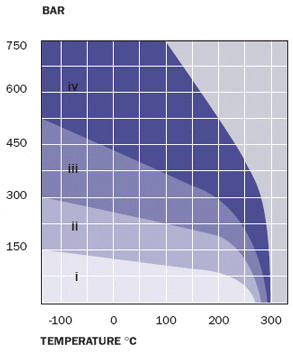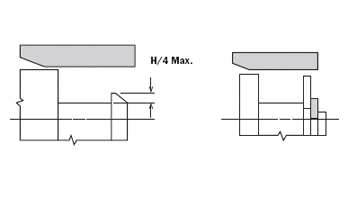Spring Energised Seals Technical Specifications
Temperature, pressure and extrusion gaps
| MATERIAL | I | II | III | IV | |
 |
UNFILLED | 0.10 | 0.07 | 0.05 | |
| Filled PTFE | 0.15 | 1.10 | 0.04 | ||
 |
Unfilled | 0.15 | 0.10 | 0.07 | |
| Filled PTFE | 0.20 | 0.15 | 0.10 | 0.07 | |
 |
Filled Back-up | 0.20 | 0.15 | 0.10 | 0.07 |
| Peek Back-up | 0.20 | 0.15 | 0.10 | 0.07 | |
 |
Filled Back-up | 0.25 | 0.20 | 0.15 | 0.10 |
| Peek Back-up | 0.35 | 0.25 | 0.20 | 0.15 |

MAXIMUM RECOMMENDED DIAMETRAL EXTRUSION GAPS
When sealing high pressure and/or temperature the clearance between the hardware "Extrusion gap" becomes very important. At high pressure and/or temperature the jacket material can extrude into the gap causing premature sealing failure. The extrusion gap should be held to the minimum practical or should not exceed above values.
Back-up rings are manufactured from a harder material than the seal material.
Spring Energised Seals Assembly Notes
Radial Seals
For Reciprocating Motion, series M20 is suitable for rod and piston applications. The M20 series has a low load, high definition spring and is suitable for general sealing at low to moderate pressures.
For more severe duties, series M01 can be considered. This design has a higher spring load but may exhibit increased friction. The design is good for moderate to high pressure sealing and for cryogenic applications (subject to confirmation by our technical department).
For Static Duty, series M01 is generally recommended for radial applications.
For Rotary Motion, both M01 and M20 series can be used, the flanged designs being the preferred choice. Due to the lighter spring load, series M20 is generally recommended but, for very slow, (under 0.25 m/s) and/or for slow/ intermittent duty at high pressures, series M01 is recommended.
Special attention should be given to the assembly of PTFE seals.
The diagrams show alternative gland designs for Spring Energised Seals, applicable to both the SE series. Split glands should be used wherever possible.
It is not recommended to fit SE series M20 to M25 into closed grooves as the spring can be damaged. In special circumstances, SE series M01 to M06 can be fitted to closed grooves and Moontown will be happy to advise on suitability and offer advice about fitting tools.
Light, clean oil or grease may be used to assist assembly. Grease with fillers should not be used, and compatibility with sealed media should be considered.

FACE SEALS (AXIAL SEALS)
For Static Duty, series M09/M10 should be considered as first choice. Due to their moderate to high spring load, they offer positive sealing over a wide temperature and pressure range. For severe duty, they very high spring loaded series M30 should be used ie.High vacuum/cryogenic and thin gas duty.
Series M20 should be used when light spring loading is essential.
For Rotary Face Seal duty at slow to moderate speeds, series M20 may be used. However, for products such as loading arms and swivels where high torques are available and where the sealing of thin gases at cryogenic temperatures is demanded, series M30 should be used.
If in doubt about any seal choice for your application, please consult our technical department.
All spring energised and hydraulic seals are available up to 2000mm diameter.
Moontown also offers a range of machined PTFE rotary shaft seals series (M50) and Metal 'O' and 'C' rings.
SEAL SMALL DIAMETER DETAILS
| C/S | Series 01 - 08 | Series 09, 10, 28 & 29 | Series 20 - 27 | Series 30 & 31 | ||||
|---|---|---|---|---|---|---|---|---|
| Min Rod | Min Bore | Min I.D. | Min O.D. | Min Rod | Min Bore | Min I.D. | Min O.D. | |
| 1 | 2 | 5 | 6 | 10 | 5 | 8 | ||
| 2 | 4 | 9 | 12 | 15 | 10 | 15 | ||
| 3 | 7 | 13 | 20 | 26 | 12 | 18 | 20 | 26 |
| 4 | 15 | 25 | 45 | 50 | 16 | 26 | 40 | 45 |
| 5 | 60 | 72 | 85 | 95 | 65 | 77 | 85 | 95 |
| 6 | 85 | 105 | 100 | 110 | 100 | 120 | 100 | 120 |
| 7 | 120 | 150 | ||||||
For diameters outside the ranges quoted, please contact Moontown.
Surface Finishes and Hardness
DYNAMIC
The quality of the surface finish influences the relative wear of the cover material. The transfer of a thin film of PTFE from the seal cover to the mating dynamic surface will improve seal life. Relatively rough finishes wear the cover material too rapidly, too smooth surfaces result in insufficient material transfer to form a thin film.
As general rule, the higher the sealing surface hardness the better the seal performance. Higher hardness reduces wear and increases seal life. A 40 HRC or higher is recommended for slow to moderate movements. The ideal hardness is between 60 and 70 HRC.
STATIC
The lay of surfaces for static face seals must be concentric.
| FLUID BEING SEALED | SURFACE FINISH | |
|---|---|---|
| DYNAMIC | STATIC | |
| Cryogenics | 0.05 to 0.2 Ra | 0.1 to 0.2 Ra |
| Helium Gas | 0.15 to 0.3 Ra | |
| Hydrogen Gas | ||
| Freon | ||
| Air | 0.15 to 0.3 Ra | 0.3 to 0.8 Ra |
| Nitrogen Gas | ||
| Argon Gas | ||
| Natural Gas | ||
| Fuel | ||
| Water | 0.2 to 0.4 Ra | 0.4 to 1.6 Ra |
| Hydraulic Oil | ||
| Crude Oil | ||
| Sealants | ||


